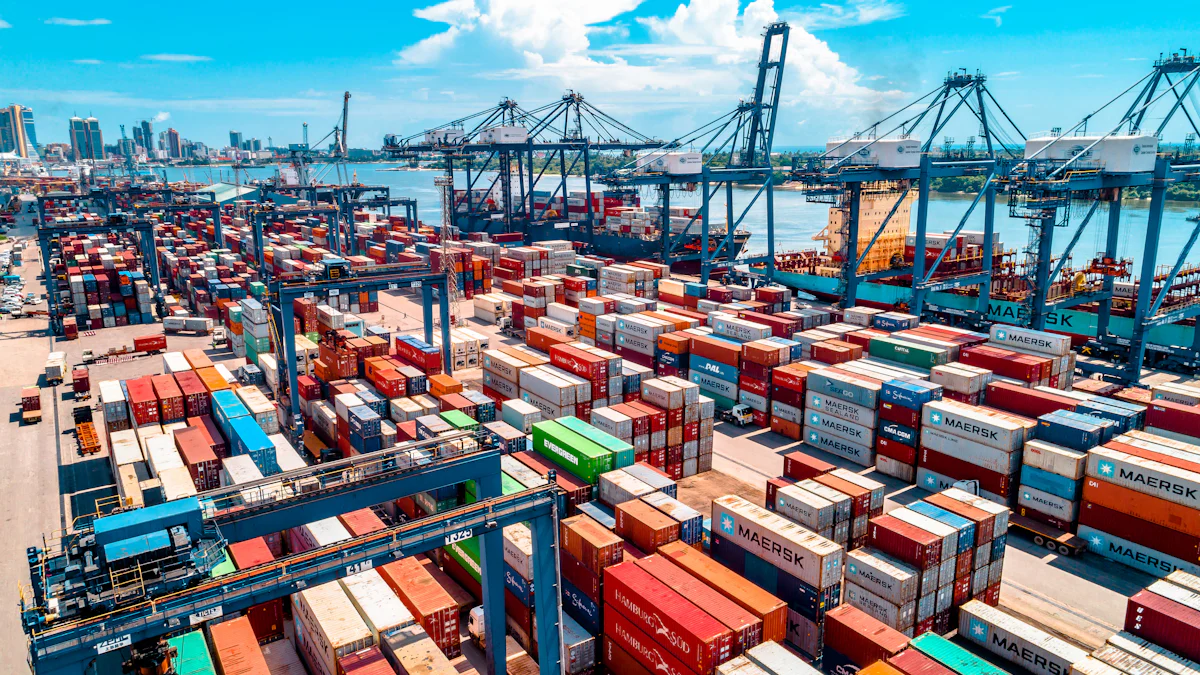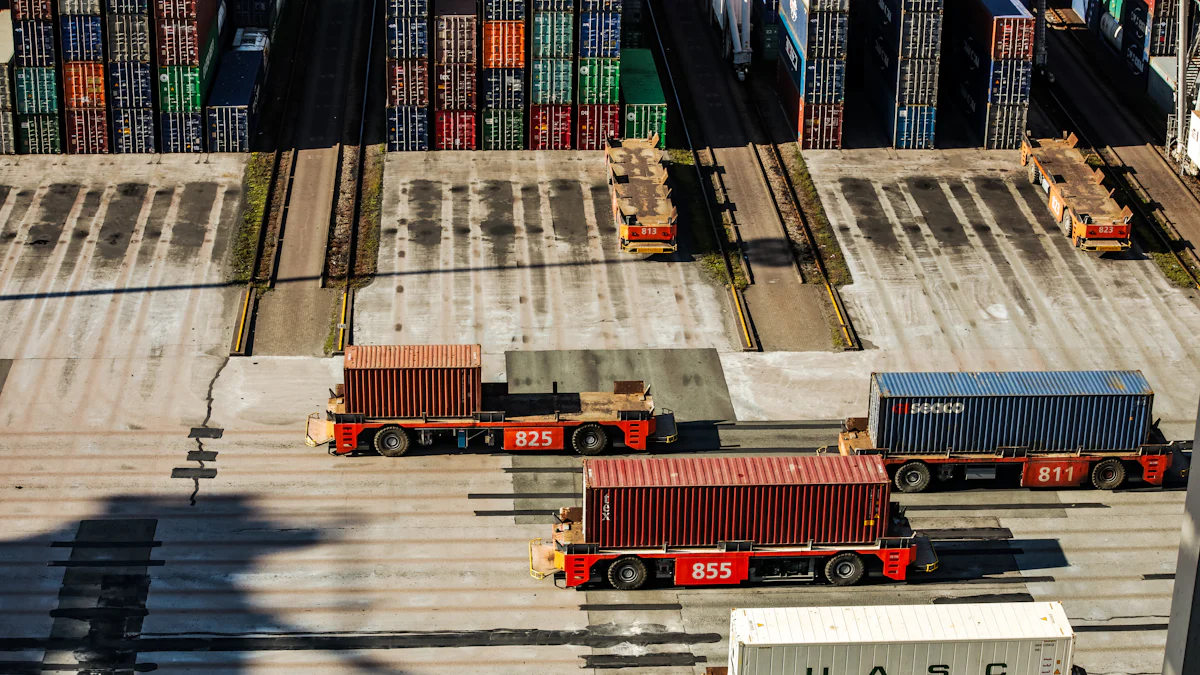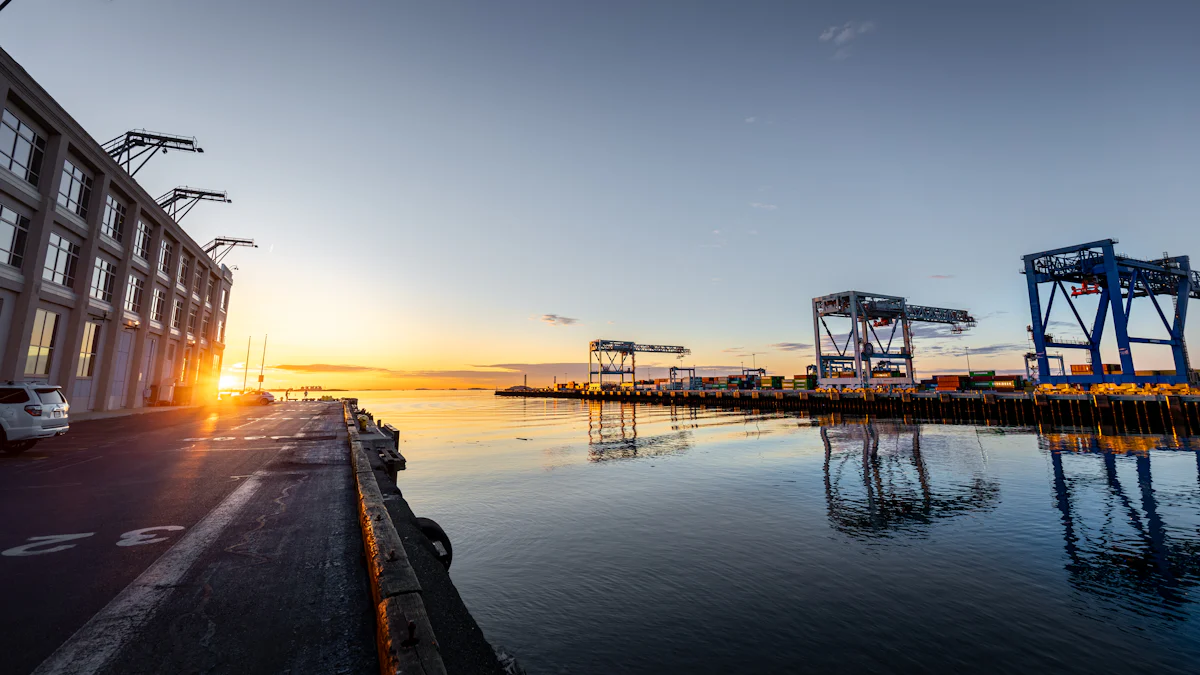Vietnam's Supply Chain Evolution: A Diversification Analysis

Vietnam's supply chain landscape has undergone significant transformation, positioning the nation as a pivotal player in global trade. The Traditional Supply Chains in Vietnam have evolved, driven by the need for diversification to mitigate risks and enhance resilience. This strategic shift aligns with Vietnam's robust economic growth, marked by steady GDP increases and substantial foreign direct investment, exceeding $25 billion in 2023. Vietnam's strategic location and burgeoning industrial zones attract manufacturers, further solidifying its role in international supply chains. As the logistics market projects to reach $61 billion by 2023, Vietnam's economic integration continues to strengthen.
Traditional Supply Chains in Vietnam
Historical Context of Vietnam's Supply Chain
Vietnam's journey in the global supply chain began long before its current prominence. The country's strategic location in Southeast Asia has always been a significant advantage, providing a natural gateway for trade routes. Over the years, Vietnam's infrastructure development played a crucial role in shaping its supply chain dynamics, ensuring seamless operations and fostering growth in global supply chains.
Pre-2000s Supply Chain Structure
Before the 2000s, Vietnam's supply chain structure was relatively simple and primarily focused on agriculture and basic manufacturing. The country relied heavily on traditional methods and local resources. During this period, Vietnam's position in the global supply chain was modest, with limited integration into international markets. However, the groundwork laid during these years set the stage for future achievements.
Post-2000s Developments
The turn of the millennium marked a significant shift in Vietnam's supply chain landscape. The government implemented policies to attract foreign direct investment, leading to rapid industrialization and modernization. Vietnam's infrastructure saw substantial improvements, enhancing its role in global supply chain dynamics. The country's stability and strategic location attracted multinational companies, strengthening its position in the global supply chain.
In recent years, Vietnam's recovery and development of new supply chains and value chains during and after the COVID-19 pandemic have opened enormous opportunities for goods trade and restructuring of supply chains. This evolution reflects Vietnam's commitment to becoming a pivotal player in the global market, leveraging its traditional supply chains to achieve greater economic integration and resilience.
Current State of Vietnam's Supply Chain

Vietnam's supply chain landscape has evolved significantly, positioning the nation as a key player in global trade. The country's strategic location and robust infrastructure have attracted numerous industries, making it a hub for manufacturing and trade.
Key Industries and Sectors
Vietnam's supply chain is heavily influenced by its key industries, which have seen substantial growth and diversification over the years.
Manufacturing and Electronics
Manufacturing forms the backbone of Vietnam's economy. The country has become a preferred destination for electronics manufacturing, with major companies setting up production facilities. Vietnam's strategic location offers easy access to raw materials and markets, enhancing its appeal to manufacturers. The government's investment in technology and innovation has further strengthened this sector, allowing Vietnam to play a crucial role in the global semiconductor supply chain.
Textile and Apparel
The textile and apparel industry remains a vital component of Vietnam's supply chain. Known for its skilled workforce and competitive labor costs, Vietnam has become a leading exporter of textiles and garments. The industry benefits from Vietnam's participation in various trade agreements, which provide access to international markets. This sector's growth reflects Vietnam's ability to adapt and thrive in a competitive global environment.
Major Trade Partners and Routes
Vietnam's supply chain is supported by its strategic trade partnerships and routes, which facilitate the movement of goods and services.
Regional Trade Agreements
Vietnam's involvement in regional trade agreements has bolstered its supply chain capabilities. Agreements such as the Comprehensive and Progressive Agreement for Trans-Pacific Partnership (CPTPP) and the Regional Comprehensive Economic Partnership (RCEP) have opened new markets and reduced trade barriers. These agreements enhance Vietnam's integration into global supply chains, providing opportunities for growth and diversification.
Strategic Partnerships with Global Economies
Vietnam has established strategic partnerships with major global economies, further strengthening its supply chain. The country's collaboration with nations like the United States, Japan, and South Korea has led to increased trade and investment. These partnerships have facilitated the transfer of technology and expertise, enabling Vietnam to enhance its supply chain resilience and competitiveness.
Vietnam's current supply chain state reflects its commitment to diversification and self-reliance. By embracing technology and sustainability, Vietnam continues to attract manufacturers and investors. The country's efforts to recover and develop new supply chains during and after the COVID-19 pandemic highlight its adaptability and potential for future growth. As Vietnam's supply chain evolves, it remains a popular choice for companies looking to shift operations and mitigate risks.
Diversification Strategies
Vietnam's supply chain evolution reflects a strategic focus on diversification. This approach aims to enhance resilience and reduce dependency on traditional supply chains in Vietnam. The country has implemented several strategies to expand its industry base and strengthen trade relations.
Expanding Industry Base
Vietnam's commitment to diversifying its industry base is evident through significant investments in technology and innovation. The government prioritizes technological advancements to boost productivity and competitiveness. By fostering a culture of innovation, Vietnam aims to transition from traditional supply chains in Vietnam to more advanced and efficient systems.
Investment in Technology and Innovation
Vietnam's investment in technology serves as a catalyst for supply chain diversification. The government encourages the adoption of cutting-edge technologies, such as automation and artificial intelligence, to optimize manufacturing processes. This technological shift enhances efficiency and reduces reliance on traditional supply chains in Vietnam. As a result, Vietnam positions itself as a leader in the global supply chain landscape.
Development of New Sectors
The development of new sectors plays a crucial role in Vietnam's diversification strategy. The country actively promotes the growth of industries beyond traditional supply chains in Vietnam. For instance, Vietnam integrates the Textile, Clothing, Leather, and Footwear sector into global supply chains and value chains. This integration not only boosts economic growth but also strengthens Vietnam's position in international markets.
Enhancing Trade Relations
Vietnam recognizes the importance of enhancing trade relations to support its diversification efforts. By forging bilateral and multilateral agreements, the country seeks to expand its reach and reduce dependency on traditional supply chains in Vietnam.
Bilateral and Multilateral Agreements
Vietnam's participation in bilateral and multilateral agreements facilitates access to new markets and reduces trade barriers. These agreements enable Vietnam to diversify its trade partners and reduce reliance on traditional supply chains in Vietnam. As a result, Vietnam strengthens its position in the global supply chain network.
Strengthening Regional Cooperation
Strengthening regional cooperation is a key component of Vietnam's diversification strategy. The country actively engages with neighboring nations to foster collaboration and enhance supply chain resilience. By working together, Vietnam and its regional partners can address common challenges and capitalize on emerging opportunities. This collaborative approach reduces dependency on traditional supply chains in Vietnam and promotes sustainable growth.
Vietnam's diversification strategies reflect a proactive approach to supply chain evolution. By expanding its industry base and enhancing trade relations, Vietnam reduces reliance on traditional supply chains in Vietnam. This strategic shift positions the country as a resilient and competitive player in the global supply chain landscape.
Challenges in Diversification
Infrastructure and Logistics
Vietnam faces significant challenges in infrastructure and logistics, which impact its supply chain diversification efforts. The country's transportation and connectivity issues hinder efficient movement of goods. Many domestic enterprises have not fully established a multimodal transport corridor, leading to inefficiencies. The demand for high-quality transshipment continues to grow, yet the operational efficiency of Vietnam's seaports remains low due to inadequate infrastructure.
Vietnam recognizes the need for further infrastructure development. The government has ambitious plans to enhance connectivity through new highways and railways, aiming to reduce travel time. Ports will undergo expansions to handle larger volumes, promising improved logistics efficiency. These projects align with Vietnam's economic goals and attract foreign investments.
Transportation and Connectivity Issues
Transportation and connectivity issues present a major hurdle for Vietnam's supply chain diversification. The lack of a comprehensive multimodal transport system limits the seamless movement of goods across the country. This gap in infrastructure affects the efficiency of supply chains, increasing costs and delivery times. To address these challenges, Vietnam must prioritize the development of integrated transport networks that connect key industrial zones and trade routes.
Need for Modernization and Investment
Modernization and investment in infrastructure are crucial for Vietnam's supply chain evolution. The government must focus on upgrading existing facilities and building new ones to support growing trade demands. Investment in advanced technologies and logistics solutions can enhance operational efficiency and reduce bottlenecks. By modernizing its infrastructure, Vietnam can strengthen its position as a competitive player in the global supply chain landscape.
Regulatory and Policy Barriers
Regulatory and policy barriers pose additional challenges to Vietnam's supply chain diversification. Manufacturers must navigate complex regulations and compliance requirements, which can slow down operations and increase costs. Understanding the rules and regulations governing Vietnam's trade agreements is essential for businesses seeking to enter the market.
Bureaucratic Hurdles
Bureaucratic hurdles create obstacles for companies looking to diversify their supply chains in Vietnam. Lengthy approval processes and complex documentation requirements can delay business operations. Streamlining administrative procedures and reducing red tape will facilitate smoother business transactions and attract more foreign investments.
Compliance with International Standards
Compliance with international standards is vital for Vietnam's integration into global supply chains. Companies must adhere to quality, safety, and environmental standards to compete in international markets. Aligning domestic regulations with global norms will enhance Vietnam's competitiveness and foster trust among international partners. By addressing regulatory and policy barriers, Vietnam can create a more conducive environment for supply chain diversification and growth.
Future Trends and Opportunities

Emerging Markets and Technologies
Vietnam's supply chain landscape is poised for transformation through emerging markets and technologies. The country embraces digital transformation, which revolutionizes supply chains by enhancing efficiency and transparency. Digital tools, such as blockchain and IoT, streamline operations and improve traceability. These technologies enable businesses to respond swiftly to market demands and reduce operational costs.
Digital Transformation in Supply Chains
Digital transformation plays a pivotal role in Vietnam's supply chain evolution. Companies leverage advanced technologies to optimize processes and enhance competitiveness. Automation and data analytics improve decision-making, allowing businesses to anticipate market trends and adapt strategies accordingly. Vietnam's commitment to digital innovation positions it as a leader in the global supply chain arena.
Potential Growth in Green Industries
Vietnam's focus on sustainability drives growth in green industries. The country prioritizes eco-friendly practices and attracts environmentally conscious investors. By promoting renewable energy and sustainable manufacturing, Vietnam reduces its carbon footprint and aligns with global sustainability goals. This commitment to green industries enhances Vietnam's reputation as a responsible and forward-thinking player in the international market.
Vietnam's dedication to sustainable practices gains global recognition. The country's efforts to combat climate change and promote eco-friendly initiatives resonate with investors and consumers alike. As Vietnam continues to integrate sustainability into its supply chain strategies, it strengthens its position as a competitive and responsible global partner.
Strategic Recommendations
To capitalize on future trends and opportunities, Vietnam must implement strategic recommendations that foster growth and resilience. These recommendations focus on policy reforms and building sustainable supply chains.
Policy Reforms and Incentives
Policy reforms play a crucial role in supporting Vietnam's supply chain evolution. The government should streamline regulations and provide incentives for businesses adopting sustainable practices. By reducing bureaucratic hurdles and offering tax benefits, Vietnam encourages companies to invest in innovative technologies and eco-friendly solutions. These reforms create a conducive environment for supply chain diversification and growth.
Building Resilient and Sustainable Supply Chains
Building resilient and sustainable supply chains is essential for Vietnam's long-term success. The country must prioritize infrastructure development and invest in modern logistics solutions. By enhancing connectivity and reducing transportation bottlenecks, Vietnam improves supply chain efficiency and reliability. Additionally, fostering collaboration with regional partners strengthens supply chain resilience and promotes sustainable growth.
Vietnam's strategic focus on emerging markets, technologies, and sustainability positions it as a dynamic player in the global supply chain landscape. By embracing digital transformation and green industries, Vietnam enhances its competitiveness and attracts international investments. Implementing policy reforms and building resilient supply chains further solidify Vietnam's role as a leader in the evolving global market.
Vietnam's supply chain evolution showcases a strategic shift towards diversification, enhancing resilience and reducing dependency on traditional methods. The country's investment in technology has attracted more investors and partners, solidifying its position in global trade. As Vietnam continues to strengthen supply chain linkages and promote domestic consumption, the future trajectory appears promising.
Key Recommendations for Stakeholders and Policymakers:
Focus on Basic Supply Chain Principles: Emphasize foundational elements to ensure efficiency and reliability.
Enhance Infrastructure: Prioritize modernization to support growing trade demands.
Foster Innovation: Encourage technological advancements to maintain competitiveness.
See Also
Overcoming Globalization's Supply Chain Expansion Hurdles
The Significance of Global Trade Supply Chains
Uncovering Robotics' Role in Revolutionizing Supply Chains
Boosting Supply Chains Through Cloud Tech Innovations
Artificial Intelligence's Impact on Future Logistics Transformation
